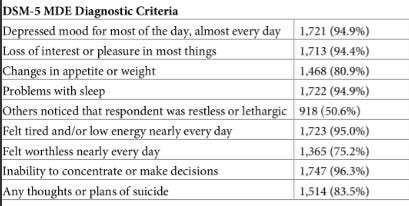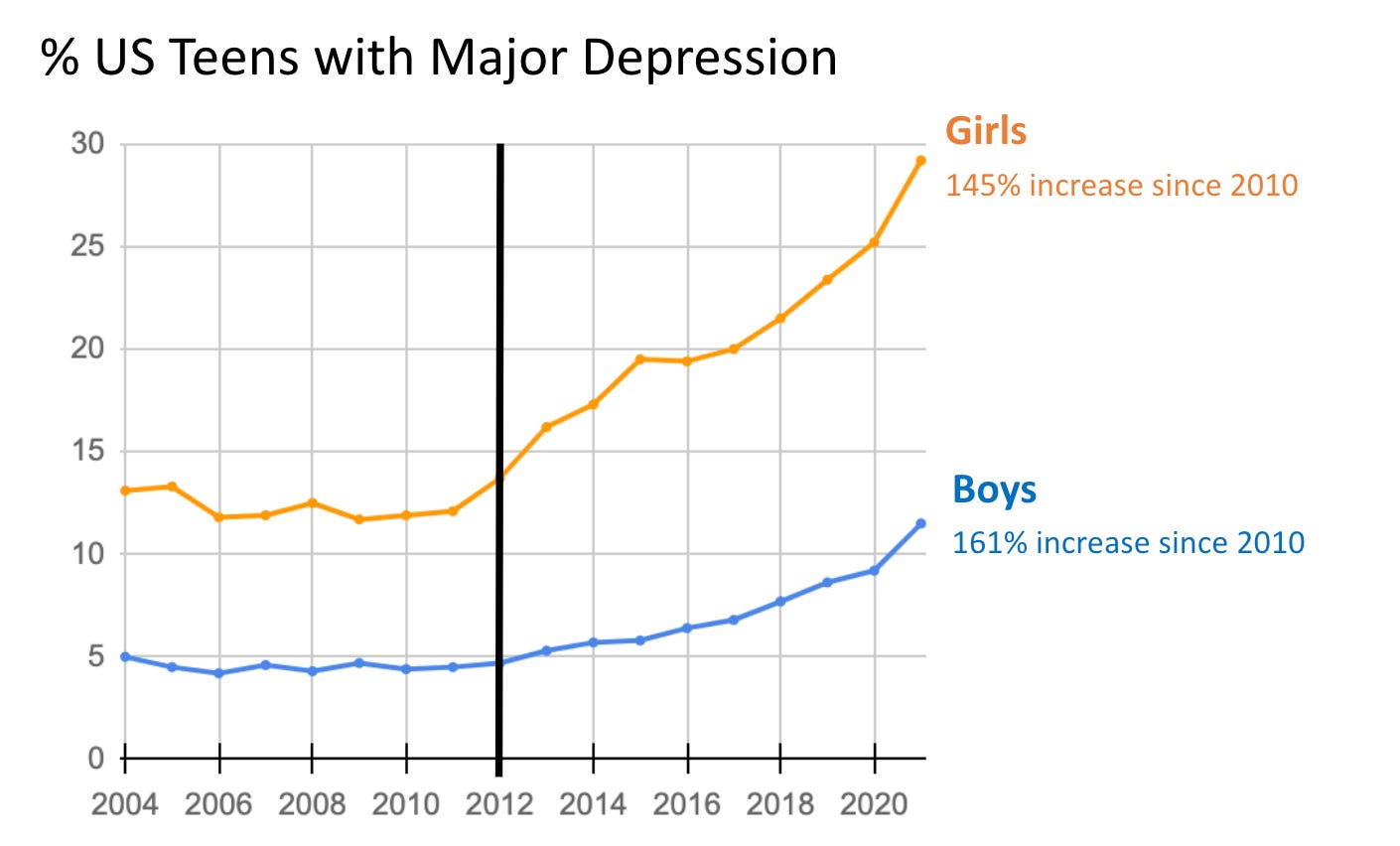Adolescent Depression: Is There Really a Crisis? (Haidt's After Babel)
Is Haidt's key measure a valid indicator of adolescent depression? Or does it merely measure a symptom?
The first and key graph offered by Haidt in The Teen Mental Illness Epidemic Began Around 2012 concerns teen depression:
Haidt asks for a high level of scrutiny: "It makes sense to embrace as a null hypothesis the skeptics’ view that there is nothing to see here, just another moral panic, and the kids are fine. I am in full agreement that the burden of proof falls on me."
We shall comply.
The Measurement Question
A fundamental question in scientific proofs is a simple one: do we actually measure what we think we are measuring?
Readers interested in adolescent mental health likely noticed, earlier this year, articles such as Depression, suicidal thoughts reach all-time high, especially in teen girls, CDC says where a "persistent sadness" item from the Youth Risk Behavior Survey (YRBS) is treated as a reliable measure of adolescent depression trends.
These news articles seldom specify the YRBS question itself (bold emphases in the original retained):
During the past 12 months, did you ever feel so sad or hopeless almost every day for two weeks or more in a row that you stopped doing some usual activities?
Clearly 'stopped doing some usual activities' need not be an unhealthy response to minor trauma, especially the kind encountered during the pandemic. That a teen whose beloved grandmother is taken to a hospital suspends some activities, like playing computer games, watching sitcoms or going shopping for clothes, does not equal depression.
It is therefore impossible to tell from this YRBS item if a positive answer is due to a minor trauma or if it indicates a mental disorder. Temporarily incapacitating sadness may in fact be a protective reaction to trauma, ensuring the youth is passive at a time when his or her mind is in turmoil.
It is of course true that trauma may trigger depression, but a population increase in one need not result in a proportional increase in the other.
For example, both trauma and depression are important risk factors for suicide -- and yet the two massive increases in the prevalence of YRBS sadness from 2017 (31.5%) to 2019 (36.7%) to 2021 (42.3%) occurred after adolescent suicide rates finally ceased to rise rapidly (though they remained disturbingly high):
Source: CDC WISQARS Fatal and Nonfatal Injury Reports
Could it be that the 'depression' indicator on which Haidt relies actually measures, like the YRBS sadness item, only minor trauma rather than major depression?
Could it be that teens these days are more resilient than Haidt thinks they are, and that, as with suicide, the recent increases in stress and trauma did not result in comparable increases in depression?
Definition of Depression
According to the DSM-IV definition of a Major Depressive Episode (MDE), one must experience, for at least two weeks, significant distress or impairment due to at least 5 of the 9 following symptoms:
Depressed Mood
Markedly diminished interest or pleasure in most or all activities
Significant weight loss (or poor appetite) or weight gain
Insomnia or hypersomnia
Psychomotor retardation
Fatigue or loss of energy
Feelings of worthlessness or excessive or inappropriate guilt
Diminished ability to think or concentrate, or indecisiveness
Recurrent thoughts of death (not just fear of dying), or suicidal ideation, plan, or attempt
Such experience is clearly far beyond a healthy reaction to minor trauma. Note also that the U.S. Food and Drug Administration approves adolescent depression screening starting at age 12.
NSDUH Measure of Major Depression
The major depression indicator in Haidt's graph comes from a national NSDUH survey.
Is the NSDUH measure a reasonable indicator of MDE per the DSM-IV definition?
The answer can be found in the National Survey on Drug Use and Health (NSDUH): Final In-Person Specifications for Programming manual from SAMHSA, which documents a series of over 50 questions designed to determine past-year adolescent MDE per DSM-IV criteria (see the Adolescent Depression section). Note that this is for ages 12-17 so adult teens are excluded -- Haidt's graph title is a bit inaccurate.
This sequence of questions is as close to an MDE evaluation as one can reasonably get in a scripted interaction.
To better understand the presence of deleterious symptoms in adolescents evaluated as having suffered an MDE, consider the following table compiled from the 2017 NSDUH results:
A figure from A survey-wide association study to identify youth-specific correlates of major depressive episodes
The table shows that, among MDE youths, the consequences of the mood disorder were considerable (such as problems with sleep and suicidal ideation).
It may of course be that clinical interviews would lead to somewhat different prevalence figures.
It is highly unlikely, however, that strong and robust trends could appear in the NSDUH survey without reflecting similar trends in clinical interviews.
Conclusion
The NSDUH measure of Major Depression is a valid indicator of MDE per DSM-IV criteria. The gradual increase of age 12-17 MDE prevalence from 8% in 2010 to 20% in 2021 is compelling evidence that adolescent mental health is in crisis.
Preview: Skeptics may grant us that mild MDE increased greatly, but posit the possibility that severe MDE -- the kind that matters the most -- need not have increased much at all. We will look into this issue next.
Appendix:
Below is the first and the last page from the Adolescent Depression section of the SAMSHA manual.
Adolescent Depression
YDS21 [IF CURNTAGE = 12-17] Have you ever in your life had a period of time lasting
several days or longer when most of the day you felt sad, empty, or depressed?
1 Yes
2 No
DK/REF
YDS22 [IF YDS21 = 2 OR DK/REF] Have you ever had a period of time lasting several days or
longer when most of the day you felt very discouraged or hopeless about how things
were going in your life?
1 Yes
2 No
DK/REF
YDS23 [IF YDS22 = 2 OR DK/REF] Have you ever had a period of time lasting several days or
longer when you lost interest and became bored with most things you usually enjoy,
like work, hobbies, and personal relationships?
1 Yes
2 No
DK/REF
YD01 [IF YDS21 = 1] During times when you felt sad, empty, or depressed most of the day,
did you ever feel discouraged about how things were going in your life?
1 Yes
2 No
DK/REF
YD01a [IF YD01 = 1] During the times when you felt sad, empty, or depressed, did you ever
lose interest and become really bored with most things like school, work, hobbies,
and other things that are usually fun for you, like listening to music, watching TV,
movies, or sports, playing computer games, or going out with friends?
1 Yes
2 No
DK/REF
YD01b [YD01 = 2 OR DK/REF] During times when you felt sad, empty, or depressed, did you
ever lose interest and become really bored with most things like school, work,
hobbies, and other things that are usually fun for you, like listening to music, watching
TV, movies, or sports, playing computer games, or going out with friends?
[... 15 pages skipped ... ]
YD86d [IF YD86c = 1] Are you currently taking prescription medication that was prescribed
for [NUMPROBS]?
1 Yes
2 No
DK/REF
YD86e [IF YD86c = 1] During the past 12 months, how much has this prescription medication
helped you?
1 Not at all
2 A little
3 Some
4 A lot
5 Extremely
DK/REF
PROGRAMMER: SHOW 12 MONTH CALENDAR
YD86f [IF YD86 = 1] During the past 12 months, how much has treatment or counseling
helped you?
1 Not at all
2 A little
3 Some
4 A lot
5 Extremely
DK/REF
PROGRAMMER: SHOW 12 MONTH CALENDAR
=========






